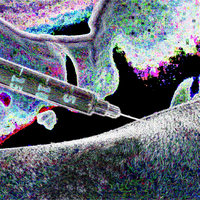| Pipradrol | |
|---|---|
| Molecular structure via molpic based on CDK |
| Physical properties [] | |
|---|---|
| Molecular mass | 267.4 g/mol [1] |
| Appearance | Crystals from hexane [1] |
| Melting point | 97.5 °C [1] |
| Decomposition | When heated to decomposition it emits toxic fumes of /nitrogen oxides/. [1] |
| Predicted LogP | 3 [1] |
| Structural Identifiers [] | |
|---|---|
| Molecular formula | C18H21NO [1] |
| IUPAC name | diphenyl(piperidin-2-yl)methanol [1] |
| SMILES | C1CCNC(C1)C(C2=CC=CC=C2)(C3=CC=CC=C3)O [1] |
| InChI | InChI=1S/C18H21NO/c20-18(15-9-3-1-4-10-15,16-11-5-2-6-12-16)17-13-7-8-14-19-17/h1-6,9-12,17,19-20H,7-8,13-14H2 [1] |
| InChIKey | XSWHNYGMWWVAIE-UHFFFAOYSA-N [1] |
Pipradrol
Pipradrol (also known as Pyridrole, Pipralon, Piridrol, Pyridrol, Pipradol, α-Pipradol, Gerodyl, Pipradrolum, Pipradrolo or α-(2-Piperidyl)benzhydrol) is a stimulant substance of the phenidate class.
Chemistry
Stereochemistry []
Pipradrol is a racemic mixture of the enantiomers
| Stereoisomers |
|---|
Subjective effects
See also []
External links []
References []
National Center for Biotechnology Information. PubChem Compound Summary for CID 10083, Pipradrol. Accessed July 24, 2025. https://pubchem.ncbi.nlm.nih.gov/compound/10083
 Anodyne
Anodyne